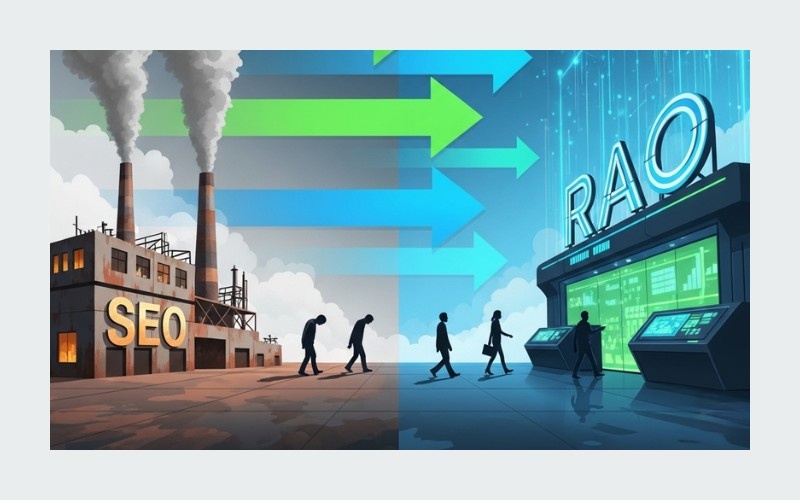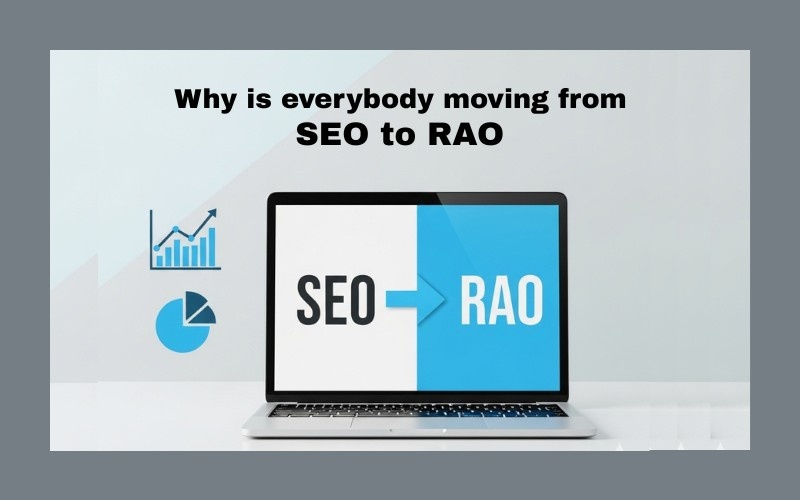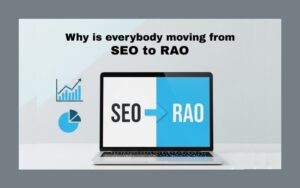The Search-Only Era is Over
The digital discovery space is in the middle of one of the most exciting transformations since the origin of the search engine. For decades, companies, advertisers, writers, and content producers lived and died by the beat of search engine optimization, or SEO. It was the lifeblood of visibility, the whispered coin that would decide whether a brand would live or disappear in the sea of digital onlookers. However, as artificial intelligence systems grow and change the way information is discovered, filtered, and relied upon, another idea is quietly seizing the limelight: Retrieval Augmentation Optimization, more commonly referred to as RAO. Abruptly, SEO is no longer the one and only supreme ruler of web visibility, and people are starting to raise the inevitable question—why is everybody moving away from SEO to RAO?
SEO’s Long Reign and Its Boundary
To comprehend this movement, let’s take a step back and remember what SEO actually stood for at its peak. Search engine optimization was how content, websites, and online properties were designed so that they would be found by search engines such as Google, Bing, or Yahoo. The algorithms of these engines favored relevance, structure, quality signals, and authority. For decades, whole industries arose to optimize for these algorithms, and practitioners learned the delicate ballet between keyword use, backlinks, freshness of content, and technical tidiness. It was a place where being seen was a game of placating the terms of a digital gatekeeper. Those who played it right rose to the top of the search, but those who did not were relegated to obscurity.
When Artificial Intelligence Altered the Rules
But then, everything changed. Artificial intelligence started to disrupt not only the way that we create content but also how we get access to it. Large language model-powered tools changed user behavior in directions few predicted. Rather than writing out searches in a search field and wading through blue link pages, users began to engage with chat-like interfaces that provided synthesized responses immediately. Instead of returning a list of possible sources, these systems pulled back knowledge directly from huge stores, enriched it with more context, and generated responses that were specific to them.
RAO: Shaping Knowledge for Machines and Humans
It’s not about making your content “findable” in a vast ocean of websites at its core. It’s about making your information retrievable, usable, and optimizable within AI system workflows. Picture asking a chatbot or a smart assistant a question regarding a particular product or service. That assistant doesn’t simply scrape the open web. It pulls data from a vetted knowledge base, adds real-time or expert data to it, and generates a response afterwards.
A Shift in Mindset: From Algorithms to Conversations
The reason why so many are departing from old-fashioned SEO to RAO is not that SEO has suddenly lost all its relevance. Search engines persist, and millions of users still depend on them every day. But the wave of behavior is changing. Like how social media revolutionized how we engaged with information a decade or so ago, AI retrieval is revolutionizing how we find and rely on knowledge today.
Why Retrieval Feels More Human
This change is psychological, too. Old SEO was more of a competition where artists pursued the whims of changing algorithms, ultimately driving to keyword saturation, over-optimization, and content that existed more for machines than humans. RAO, on the other hand, challenges a different state of mind. It encourages companies to care about clarity, contextual relevance, and organizing their knowledge in formats where AI can naturally leverage it.
Beyond Marketing: RAO in Enterprise and Research
Another factor fueling this migration is the growth in enterprise uptake of AI systems. Firms now are not only optimizing for public search engines but for private, domain-specific retrieval systems. Consider hospitals constructing AI systems that can pull in medical records and research data in a flash, or law firms employing retrieval-augmented models to process decades of case law.
The Technical Core of RAO
The technology behind RAO is also noteworthy since it explains why this change is not only hype but a necessity. Conventional SEO was based on optimizing HTML pages for keyword prominence and link strength. RAO, however, communicates with systems that are fueled by large language models that are reliant on strong retrieval pipelines.
However, it would be a fallacy to imagine RAO as only a technical problem. At its core, RAO is trust. Users will trust an AI system’s synthesized answer more than a random blog they came across while searching. This makes it imperative for brands to make sure their information is properly represented in the data sources that supply these systems.
From Search Rankings to Answer Presence
The financial implications are staggering. Whole industries grew up around SEO—agencies, tools, consultancies, and training academies. As RAO grows, they will have to reinvent themselves. The game of optimization is not going away; it is changing.

After the User, Not the Algorithm
Maybe the best indication that everyone is making a switch from SEO to RAO is in user behavior. Ultimately, optimization is there to serve the user. Users don’t want to sift through page after page of search results. They’re hungry for direct, reliable answers.
SEO Is Not Dead, But the Balance Is Shifting
And yet, it would be naive to pose it as a total replacement. SEO is not dead, nor will it ever disappear completely. Rather, we are seeing an overlap, a hybrid stage where both SEO and RAO exist side by side.
A Cultural Transformation in Digital Knowledge
The transition from SEO to RAO is, thus, not only a technological shift but also a cultural one. It is an index of a more extensive shift in the way humans engage with information.
Case Studies: RAO in Action Across Industries
Industries are already seeing the beginnings of the impact. In e-commerce, the old SEO used to determine whether your product page appeared above others. Now, retrieval-augmented AI shopping assistants are becoming more popular. Healthcare, law, academia, and publishing are also changing with this new way.
The Return of Natural Writing
The cultural ramifications of this change cannot be overlooked either. SEO defined online writing in a manner that tended to drain it of creativity. Articles were filled with keywords, written in stock structures, and optimized for scanning over content rather than profundity. RAO, though, enables content to revert to natural expression.
Machines That Adapt to Us
The technical aspect of RAO also shows why it is the future and not just a trend. In the SEO age, humans accommodated their behavior to suit the machine. In the RAO age, machines accommodate human beings.
When the Giants Move, Everyone Follows
It’s also worth looking at how the big players in tech are telegraphing the inevitability of this shift. Google, Microsoft, and enterprise software companies are deeply integrating retrieval augmentation into their ecosystems.
Authority in the Age of AI Mediation
For companies, this change is not merely technical, but strategic. SEO previously promised visibility by means of ranking. RAO puts authority squarely in the hands of AI systems.
Short-Term Doubts, Long-Term Inevitability
Critics might respond that RAO is still young and SEO is still more crucial in the short term. But the long-term trend is clear.
Fairness, Ethics, and the New Visibility
The move to RAO also challenges fairness, transparency, and ethics. SEO was criticized for rewarding manipulation. RAO escapes some of those issues but also generates new ones.
The Future Belongs to RAO
Moving forward, RAO can even redefine the meaning of being visible online. Visibility in the world of SEO meant getting listed on the first page of search results. In the RAO world, it means being part of the answer itself.
A Paradigm Shift, Not Just a Trend
What makes this moment so interesting is that it is simultaneously familiar and completely new. Familiar, because optimization has ever trailed behind the platforms users employ to find information. New, because RAO is not merely a change of platform but a change of paradigm.When Optimization Becomes Conversation
One of the most dramatic facts about this transition is that optimization is no longer a matter of getting content in front of machines; it’s a matter of orchestrating conversations that humans will have with machines. During the SEO age, a brand’s holy grail was to show up at the top of a search engine page. That position equated to clicks, traffic, and ultimately sales or fame. But during the RAO era, the dream was changed. The dream is to be integral to the answer itself, integrated into the storytelling that a smart assistant constructs when a human poses a query. This is a far more intimate kind of visibility. Rather than waiting on a busy street corner with a sign, you are waiting in someone’s living room to answer their questions directly.
This dialogic nature of RAO brings a more human touch to optimization. Creators and brands now need to picture themselves as contributors to an ongoing conversation, rather than as publishers of content fighting for clicks. Each item of information they drop into the world needs to be prepared to be retrieved, understood, and spoken by an AI system. Precision, clarity, and context are now more important than ever. A garbled, jargon-heavy description that once may have been ranked because of backlinks can now be kept out of retrieval since the system cannot effectively use it in discourse.














